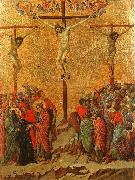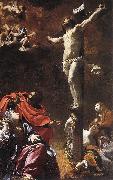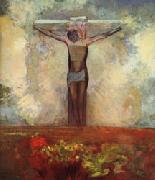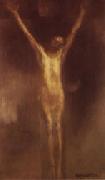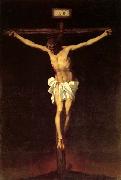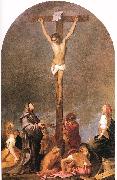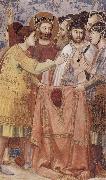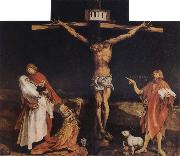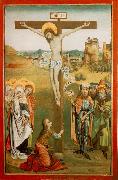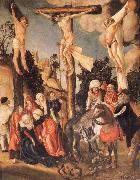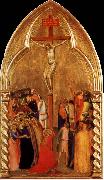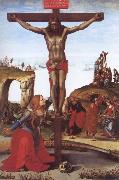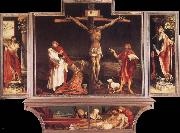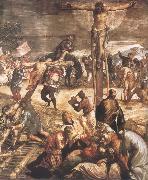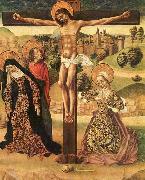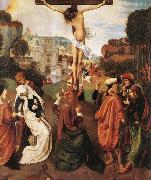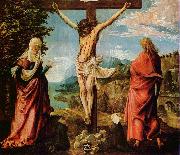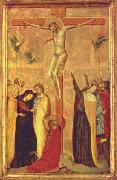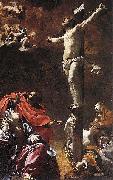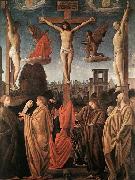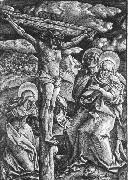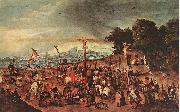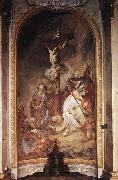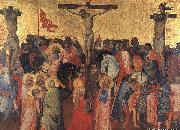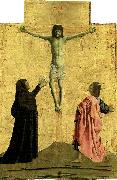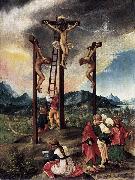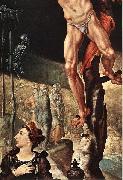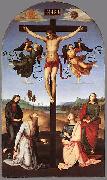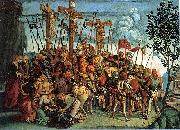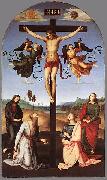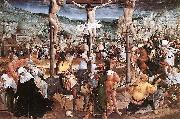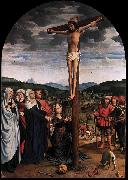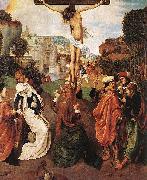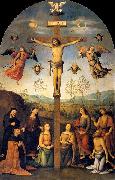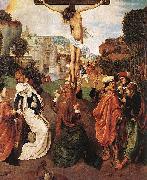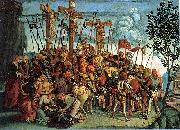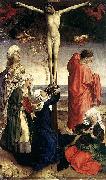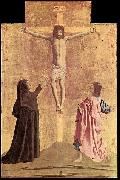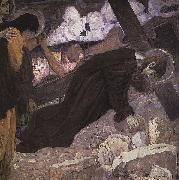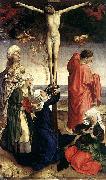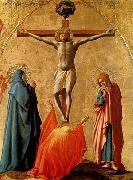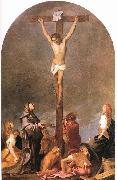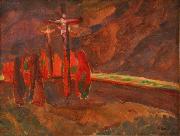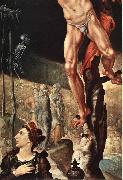Wholesale Oil Painting No Minimum |
|||||||||||
|
|
|||||||||||

|
|||||||||||
|
|
|
||||||||
Duccio di Buoninsegna1255-1318 Italian Duccio di Buoninsegna Locations Italian painter. He was one of the most important painters of the 14th century and like his slightly younger contemporary, Giotto, was a major influence on the course of Italian painting. An innovator, he introduced into Sienese painting new altarpiece designs, a dramatic use of landscape, expressive emotional relationships, extremely complex spatial structures and a subtle interplay of colour. His most important and revolutionary work, the Maeste for Siena Cathedral, was never matched during the 14th century, if at all, and his influence lasted well into the 15th century. |
||||||||
|
|
||||||||
Crucifixion
Crucifixion Painting ID:: 261 |
Museo dell'Opera del Duomo, Siena Museo dell'Opera del Duomo, Siena |
|||||||
|
|
||||||||
|
|
||||||||
|
|
Crucifixion
Crucifixion Painting ID:: 10140 |
1622
Oil on canvas,
375 x 225 cm
Chiesa del Gesu
Genoa 1622 Oil on canvas, 375 x 225 cm Chiesa del Gesu Genoa |
||||||
|
|
||||||||
Odilon RedonFrench Symbolist Painter, 1840-1916 Bertrand-Jean Redon, better known as Odilon Redon (April 20, 1840 ?C July 6, 1916) was a Symbolist painter and printmaker, born in Bordeaux, Aquitaine, France. Odilon was a nickname derived from his mother, Odile. Redon started drawing as a young child, and at the age of 10 he was awarded a drawing prize at school. At age 15, he began formal study in drawing but on the insistence of his father he switched to architecture. His failure to pass the entrance exams at Paris?? Ecole des Beaux-Arts ended any plans for a career as an architect, although he would later study there under Jean-L??on Gerôme. Back home in his native Bordeaux, he took up sculpture, and Rodolphe Bresdin instructed him in etching and lithography. However, his artistic career was interrupted in 1870 when he joined the army to serve in the Franco-Prussian War. At the end of the war, he moved to Paris, working almost exclusively in charcoal and lithography. It would not be until 1878 that his work gained any recognition with Guardian Spirit of the Waters, and he published his first album of lithographs, titled Dans le R??ve, in 1879. Still, Redon remained relatively unknown until the appearance in 1884 of a cult novel by Joris-Karl Huysmans titled, À rebours (Against Nature). The story featured a decadent aristocrat who collected Redon's drawings. In the 1890s, he began to use pastel and oils, which dominated his works for the rest of his life. In 1899, he exhibited with the Nabis at Durand-Ruel's. In 1903 he was awarded the Legion of Honor. His popularity increased when a catalogue of etchings and lithographs was published by Andr?? Mellerio in 1913 and that same year, he was given the largest single representation at the New York Armory Show. In 1923 Mellerio published: Odilon Redon: Peintre Dessinateur et Graveur. An archive of Mellerio's papers is held by the Ryerson & Burnham Libraries at the Art Institute of Chicago. In 2005 the Museum of Modern Art launched an exhibition entitled "Beyond The Visible", a comprehensive overview of Redon's work showcasing more than 100 paintings, drawings, prints and books from The Ian Woodner Family Collection. The exhibition ran from October 30, 2005 to January 23, 2006. |
||||||||
|
|
||||||||
|
|
Crucifixion
Crucifixion Painting ID:: 11684 |
ca 1910
10'' x 1' 6 1/2''(25.7 x 47.1 cm)Bequest of Mrs.Ari Redon,1982 ca 1910 10'' x 1' 6 1/2''(25.7 x 47.1 cm)Bequest of Mrs.Ari Redon,1982 |
||||||
|
|
||||||||
Eugene CarriereFrench Symbolist Painter, 1849-1906 French painter and lithographer. He is best known for his spiritual interpretations of maternity and family life. Characteristic are his Crucifixion and Maternity (both: Louvre). He also painted some large canvases for the Sorbonne and the Hôtel de Ville, Paris. Among his works are many notable portraits, including those of Verlaine, Daudet, and Edmond de Goncourt. |
||||||||
|
|
||||||||
|
|
Crucifixion
Crucifixion Painting ID:: 11691 |
Salon of 1897
7 5 1/4'' x 4 3 1/4''(227 x 130 cm) Salon of 1897 7 5 1/4'' x 4 3 1/4''(227 x 130 cm) |
||||||
|
|
||||||||
Francisco de Zurbaran1598-1664 Spanish Francisco de Zurbaran Galleries Spanish baroque painter, active mainly at Llerena, Madrid, and Seville. He worked mostly for ecclesiastical patrons. His early paintings, including Crucifixion (1627; Art Inst., Chicago), St. Michael (Metropolitan Mus.), and St. Francis (City Art Museum, St. Louis), often suggest the austere simplicity of wooden sculpture. The figures, placed close to the picture surface, are strongly modeled in dramatic light against dark backgrounds, indicating the influence of Caravaggio. They were clearly painted as altarpieces or devotional objects. In the 1630s the realistic style seen in his famous Apotheosis of St. Thomas Aquinas (1631; Seville) yields to a more mystical expression in works such as the Adoration of the Shepherds (1638; Grenoble); in this decade he was influenced by Ribera figural types and rapid brushwork. While in Seville, Zurbur??n was clearly influenced by Velazquez. After c.1640 the simple power of Zurbaran work lessened as Murillo influence on his painting increased (e.g., Virgin and Child with St. John, Fine Arts Gall., San Diego, Calif.). There are works by Zurbar??n in the Hispanic Society of America, New York City; the National Gallery, Washington, D.C.; and the Philadelphia Museum of Art.. |
||||||||
|
|
||||||||
|
|
Crucifixion
Crucifixion Painting ID:: 29181 |
mk65
1650s
Oil on canvas
104x38'
mk65 1650s Oil on canvas 104x38' |
||||||
|
|
||||||||
CARPIONI, GiulioItalian painter, Venetian school (1613-1674) |
||||||||
|
|
||||||||
|
|
Crucifixion
Crucifixion Painting ID:: 32276 |
c. 1648
Oil on canvas, 205 x 131 cm c. 1648 Oil on canvas, 205 x 131 cm |
||||||
|
|
||||||||
GIOTTO di BondoneItalian Early Renaissance Painter, 1267-1337 Italian painter and designer. In his own time and place he had an unrivalled reputation as the best painter and as an innovator, superior to all his predecessors, and he became the first post-Classical artist whose fame extended beyond his lifetime and native city. This was partly the consequence of the rich literary culture of two of the cities where he worked, Padua and Florence. Writing on art in Florence was pioneered by gifted authors and, although not quite art criticism, it involved the comparison of local artists in terms of quality. The most famous single appreciation is found in Dante's verses (Purgatory x) of 1315 or earlier. Exemplifying the transience of fame, first with poets and manuscript illuminators, Dante then remarked that the fame of Cimabue, who had supposed himself to be the leader in painting, had now been displaced by Giotto. Ironically, this text was one factor that forestalled the similar eclipse of Giotto's fame, which was clearly implied by the poet. |
||||||||
|
|
||||||||
|
|
Crucifixion
Crucifixion Painting ID:: 33298 |
mk86
1303-1305
Fresco
Padua
Arena Chapel
mk86 1303-1305 Fresco Padua Arena Chapel |
||||||
|
|
||||||||
Grunewald, MatthiasGerman Northern Renaissance Painter, ca.1470-1528 .the traditional name of a painter whose real name is believed to have been Nithardt or Neithardt. He was active at Isenheim nr. Colmar c.1514 and in Frankfurt c.1526. Gr??newald's principal work, an elaborate altarpiece of many panels painted for the monastery at Isenheim (Isenheimer Altar), is now in the Colmar museum. |
||||||||
|
|
||||||||
|
|
Crucifixion
Crucifixion Painting ID:: 33517 |
mk86
1512-1516
Oil on wood
269x307cm
mk86 1512-1516 Oil on wood 269x307cm |
||||||
|
|
||||||||
|
|
||||||||
|
|
Crucifixion
Crucifixion Painting ID:: 38396 |
c. 1476
Tempera on wood, 154 x 98 cm
Hungarian National Gallery, Budapest c. 1476 Tempera on wood, 154 x 98 cm Hungarian National Gallery, Budapest |
||||||
|
|
||||||||
Lucas Cranach the Elderb. 1472, Kronach, d. 1553, Weimar. German painter and printmaker. He took his name from the town of his birth. Little is known about his early life or training. In Vienna (c. 1501 ?C 04) he painted some notable portraits and landscapes characteristic of the Danube school. From 1505 to 1550 he was court painter in Wittenberg, where he achieved great success and wealth painting portraits, mythological subjects, and altarpieces for Protestant and Catholic churches. He attracted so many young artists to Wittenberg that the town became an art centre. A friend of Martin Luther, Cranach became known as the chief pictorial propagandist of the Protestant cause in Germany. He produced numerous engravings and more than 100 woodcuts, notably for the first German edition of the New Testament (1522). After his death, his style was perpetuated by his son, Lucas the Younger (1515 C 86). |
||||||||
|
|
||||||||
|
|
Crucifixion
Crucifixion Painting ID:: 39702 |
mk150
c.1500/1501
58.5x45cm
mk150 c.1500/1501 58.5x45cm |
||||||
|
|
||||||||
Bernardo Daddiactive in Florence 1320-1348 was an early Italian renaissance painter and apprentice of Giotto. He was also influenced by the Sienese art of Lorenzetti. Daddi's birth date remains unknown. He is first mentioned in 1312. He focused on religious motifs and altarpieces. A triptych he painted in 1328 is in the Uffizi, and there are several panels in National Gallery of Art and the Walters Art Gallery. Daddi became the leading painter of Florence during his generation. His last work dates from 1347, |
||||||||
|
|
||||||||
|
|
Crucifixion
Crucifixion Painting ID:: 40144 |
mk156
c.1335
Tempera on panel
36x23.5cm
The National Gallery of Art.
Washington D.C
mk156 c.1335 Tempera on panel 36x23.5cm The National Gallery of Art. Washington D.C |
||||||
|
|
||||||||
Luca SignorelliCrtona 1441-1523 .Italian painter of the Umbrian school, who probably studied with Piero della Francesca. He worked in Cortona, where some of his paintings have remained. Subsequently he worked in the Cathedral of Perugia, in Volterra, and at Monte Oliveto before undertaking (1499) the decoration of the Cappella Nuova in the Orvieto Cathedral. There he represented the apocalyptic series of the Story of the Anti-Christ, the End of the World, the Resurrection of the Bodies, Paradise, and the Inferno, as well as figurations from antique poems and the Divine Comedy. The infernal scenes are remarkable for their imaginative evocation of fiends and tortures of Hell. Michelangelo was influenced by his powerful treatment of anatomy and the vivid realism he used for dramatic ends. Signorelli's paintings in the Vatican, where he went in 1508, were later sacrificed to make way for some of Raphael's work. |
||||||||
|
|
||||||||
|
|
Crucifixion
Crucifixion Painting ID:: 40286 |
mk156
c.1500
Oil on canvas
247x117.5cm
mk156 c.1500 Oil on canvas 247x117.5cm |
||||||
|
|
||||||||
Grunewald, MatthiasGerman Northern Renaissance Painter, ca.1470-1528 .the traditional name of a painter whose real name is believed to have been Nithardt or Neithardt. He was active at Isenheim nr. Colmar c.1514 and in Frankfurt c.1526. Gr??newald's principal work, an elaborate altarpiece of many panels painted for the monastery at Isenheim (Isenheimer Altar), is now in the Colmar museum. |
||||||||
|
|
||||||||
|
|
Crucifixion
Crucifixion Painting ID:: 40306 |
mk156
1515
Oil on wood
269x307cm
mk156 1515 Oil on wood 269x307cm |
||||||
|
|
||||||||
TintorettoItalian Mannerist Painter, ca.1518-1594 His father was a silk dyer (tintore); hence the nickname Tintoretto ("Little Dyer"). His early influences include Michelangelo and Titian. In Christ and the Adulteress (c. 1545) figures are set in vast spaces in fanciful perspectives, in distinctly Mannerist style. In 1548 he became the centre of attention of artists and literary men in Venice with his St. Mark Freeing the Slave, so rich in structural elements of post-Michelangelo Roman art that it is surprising to learn that he had never visited Rome. By 1555 he was a famous and sought-after painter, with a style marked by quickness of execution, great vivacity of colour, a predilection for variegated perspective, and a dynamic conception of space. In his most important undertaking, the decoration of Venice's Scuola Grande di San Rocco (1564 C 88), he exhibited his passionate style and profound religious faith. His technique and vision were wholly personal and constantly evolving. |
||||||||
|
|
||||||||
|
|
Crucifixion
Crucifixion Painting ID:: 40385 |
mk156
1565
Oil on canvas
536x1224cm
mk156 1565 Oil on canvas 536x1224cm |
||||||
|
|
||||||||
TINTORETTO, JacopoBirth Year:, 1518. Death Year:, 1594 |
||||||||
|
|
||||||||
|
|
Crucifixion
Crucifixion Painting ID:: 41142 |
mk157
1565
Oil on canvas
536x1224cm
mk157 1565 Oil on canvas 536x1224cm |
||||||
|
|
||||||||
MASTER of BudapestSpanish painter active c. 1500 in Castile |
||||||||
|
|
||||||||
|
|
Crucifixion
Crucifixion Painting ID:: 43549 |
1501-1550
c. 1500 Tempera on canvas
85 x 67,3 cm 1501-1550 c. 1500 Tempera on canvas 85 x 67,3 cm |
||||||
|
|
||||||||
Master of Virgo inter VirginesNetherlandish Painter, active 1470-1520 |
||||||||
|
|
||||||||
|
|
Crucifixion
Crucifixion Painting ID:: 43565 |
1490s
Oil on wood
57 x 47 cm 1490s Oil on wood 57 x 47 cm |
||||||
|
|
||||||||
Albrecht AltdorferGerman 1480-1538 Albrecht Altdorfer Galleries He most often painted religious scenes, but is mainly famous as the first frequent painter of pure landscape, and also compositions dominated by their landscape. Taking and developing the landscape style of Lucas Cranach the Elder, he shows the hilly landscape of the Danube valley with thick forests of drooping and crumbling firs and larches hung with moss, and often dramatic colouring from a rising or setting sun. His Landscape with footbridge (National Gallery, London) of 1518-20 is claimed to be the first pure landscape in oil. He also made many fine finished drawings, mostly landscapes, in pen and watercolour. His best religious scenes are intense, sometimes verging on the expressionistic, and often depict moments of intimacy between Christ and his mother, or others. His most famous religious artwork is the The Legend of St. Sebastian and the Passion of Christ that decorated the altar in the St. Florian monastery in Linz, Austria. He often distorts perspective to subtle effect. His donor figures are often painted completely out of scale with the main scene, as in paintings of the previous centuries. He also painted some portraits; overall his painted oeuvre was not large. |
||||||||
|
|
||||||||
|
|
Crucifixion
Crucifixion Painting ID:: 58198 |
Crucifixion (a scene rarely set on the banks of a large river) by Altdorfer, c. 1520 Crucifixion (a scene rarely set on the banks of a large river) by Altdorfer, c. 1520 |
||||||
|
|
||||||||
Bernardo Daddiactive in Florence 1320-1348 was an early Italian renaissance painter and apprentice of Giotto. He was also influenced by the Sienese art of Lorenzetti. Daddi's birth date remains unknown. He is first mentioned in 1312. He focused on religious motifs and altarpieces. A triptych he painted in 1328 is in the Uffizi, and there are several panels in National Gallery of Art and the Walters Art Gallery. Daddi became the leading painter of Florence during his generation. His last work dates from 1347, |
||||||||
|
|
||||||||
|
|
Crucifixion
Crucifixion Painting ID:: 58521 |
Crucifixion (1340-1345) Crucifixion (1340-1345) |
||||||
|
|
||||||||
Simon Vouetb. 1590, Paris, d. 1649, Paris.French painter and draughtsman. Although at the time regarded as one of the leading French painters of the first half of the 17th century, he is now known more for his influence on French painting than for his actual oeuvre. He made his reputation in Italy, where he executed numerous portraits for aristocratic patrons and was commissioned for religious subjects. Although the early Italian works show the influence of Caravaggio, his work was subsequently modified by the Baroque style of such painters as Lanfranco and the influence of the Venetian use of light and colour. |
||||||||
|
|
||||||||
|
|
Crucifixion
Crucifixion Painting ID:: 61484 |
Chiesa del Ges??, G??nes,375 X 225 cm.1622 Chiesa del Ges??, G??nes,375 X 225 cm.1622 |
||||||
|
|
||||||||
BRAMANTINOItalian High Renaissance Painter, ca.1460-1530 Leonaert/Leonard Bramer alias Nestelghat (Dec 24, 1596, Delft - buried Feb 10, 1674, Delft) was a Dutch painter, best known for probably being one of the teachers of Johannes Vermeer, although there is no similarity between their work. Bramer's dark and exotic style is unlike Vermeer's style. Bramer was primarily a genre and history painter, but also made some unique frescos, not very often found north of the Alps. Leonaert Bramer is one of the most intriguing personalities in seventeenth-century Dutch art. He was a talented and diligent draughtsman, evidently Catholic and a life long bachelor. |
||||||||
|
|
||||||||
|
|
Crucifixion
Crucifixion Painting ID:: 63534 |
1515 Oil on canvas, 372 x 270 cm Pinacoteca di Brera, Milan This painting may have come from the church of S. Maria di Brera. At one time it was probably an organ shutter. It was formerly attributed to Bramante. A late work, this painting reveals Bramantino's background. His roots were in the art of Ercole de' Roberti, the most energetically emotional fifteenth- century painter in northern Italy. It is from this source that Bramantino drew his highly dramatic style, which led him to freeze the tragedy of the Crucifixion within a framework of lucid abstraction. At the same time he seized the opportunity to seek out new means of formal expression. The crosses of the two thieves are arranged in terms of a centralized perspective, creating a space almost like an interior, and leading directly to the background where typical Bramantino buildings are silhouetted against an evening sky. (One of the buildings resembles the Trivulzio mausoleum, which was designed by the artist.) The marked bisymmetry of the painting, with angel and demon, sun and moon, is less structured in the choral rhythm of the foreground. The Madonna's grief is represented within the circle described by the hands of the saints, while the Magdalene lifts her arms toward the cross as if to raise it up to heaven. A strict intellectual approach dominates the colour scheme, in which subdued olive greens, golden grays and browns predominate.Artist:BRAMANTINO Title: Crucifixion Painted in 1451-1500 , Italian - - painting : religious 1515 Oil on canvas, 372 x 270 cm Pinacoteca di Brera, Milan This painting may have come from the church of S. Maria di Brera. At one time it was probably an organ shutter. It was formerly attributed to Bramante. A late work, this painting reveals Bramantino's background. His roots were in the art of Ercole de' Roberti, the most energetically emotional fifteenth- century painter in northern Italy. It is from this source that Bramantino drew his highly dramatic style, which led him to freeze the tragedy of the Crucifixion within a framework of lucid abstraction. At the same time he seized the opportunity to seek out new means of formal expression. The crosses of the two thieves are arranged in terms of a centralized perspective, creating a space almost like an interior, and leading directly to the background where typical Bramantino buildings are silhouetted against an evening sky. (One of the buildings resembles the Trivulzio mausoleum, which was designed by the artist.) The marked bisymmetry of the painting, with angel and demon, sun and moon, is less structured in the choral rhythm of the foreground. The Madonna's grief is represented within the circle described by the hands of the saints, while the Magdalene lifts her arms toward the cross as if to raise it up to heaven. A strict intellectual approach dominates the colour scheme, in which subdued olive greens, golden grays and browns predominate.Artist:BRAMANTINO Title: Crucifixion Painted in 1451-1500 , Italian - - painting : religious |
||||||
|
|
||||||||
BALDUNG GRIEN, HansGerman Northern Renaissance Painter and Printmaker, ca.1484-1545 |
||||||||
|
|
||||||||
|
|
Crucifixion
Crucifixion Painting ID:: 63688 |
1511 Chiaroscuro woodcut, 347 x 260 mm Germanisches Nationalmuseum, NurembergArtist:BALDUNG GRIEN, Hans Title: Crucifixion Painted in 1501-1550 , German - - graphics : religious 1511 Chiaroscuro woodcut, 347 x 260 mm Germanisches Nationalmuseum, NurembergArtist:BALDUNG GRIEN, Hans Title: Crucifixion Painted in 1501-1550 , German - - graphics : religious |
||||||
|
|
||||||||
BRUEGHEL, Pieter the YoungerFlemish painter (b. 1564, Bruxelles, d. 1638, Antwerp). Pieter Brueghel the Younger was the oldest son of the famous sixteenth-century Netherlandish painter Pieter Brueghel the Elder (known as "Peasant Brueghel") and Mayken Coecke van Aelst. His father died in 1569, when Pieter the younger was only five years old. Then, following the death of his mother in 1578, Pieter, along with his brother Jan Brueghel the Elder ("Velvet Brueghel") and sister Marie, went to live with their grandmother Mayken Verhulst (widow of Pieter Coecke van Aelst). She was an artist in her own right, and according to Carel van Mander, possibly the first teacher of the two sons. The family moved to Antwerp sometime after 1578 and Pieter possibly entered the studio of the landscape painter Gillis van Coninxloo (1544-1607). In the 1584/1585 registers of Guild of Saint Luke, "Peeter Brugel" is listed as an independent master. On November 5, 1588 he married Elisabeth Goddelet, and the couple had seven children. He painted landscapes, religious subjects and fantasy paintings. For this last category he often made use of fire and grotesque figures, leading to his nickname "Hell Brueghel". Apart from these paintings of his own invention, Pieter Brueghel the Younger also copied the works his father had created by using a technique called pouncing. His genre paintings of peasants lack Pieter the Elder's subtlety and humanism, and emphasize the picturesque. |
||||||||
|
|
||||||||
|
|
Crucifixion
Crucifixion Painting ID:: 64484 |
1617 Oil on wood, 82 x 123 cm Museum of Fine Arts, Budapest It is assumed that the painting is copy of lost painting of Pieter Bruegel the Elder. There are several other copies differring only in the background. Artist:BRUEGHEL, Pieter the Younger Title: Crucifixion, 1551-1600, Flemish , painting , religious 1617 Oil on wood, 82 x 123 cm Museum of Fine Arts, Budapest It is assumed that the painting is copy of lost painting of Pieter Bruegel the Elder. There are several other copies differring only in the background. Artist:BRUEGHEL, Pieter the Younger Title: Crucifixion, 1551-1600, Flemish , painting , religious |
||||||
|
|
||||||||
MAULBERTSCH, Franz AntonAustrian Painter, 1724-1796 Austrian painter. His work as a painter of both oil paintings and frescoes on religious, mythological and occasionally worldly themes spanned the second half of the 18th century, adapting a Late Baroque training to the onset of Neo-classicism but remaining strikingly individual throughout. His fresco work, mostly still in situ in widespread central European locations, came at the end of an artistic tradition and was for long neglected, being far from major cultural centres; but it is now seen to establish him as one of the leading painters of his century |
||||||||
|
|
||||||||
|
|
Crucifixion
Crucifixion Painting ID:: 64576 |
1758 Fresco Parish Church, S?meg Artist:MAULBERTSCH, Franz Anton Title: Crucifixion, 1751-1800, Austrian , painting , religious 1758 Fresco Parish Church, S?meg Artist:MAULBERTSCH, Franz Anton Title: Crucifixion, 1751-1800, Austrian , painting , religious |
||||||
|
|
||||||||
GADDI, AgnoloItalian Early Renaissance Painter, ca.1345-1396 |
||||||||
|
|
||||||||
|
|
Crucifixion
Crucifixion Painting ID:: 64767 |
1390-96 Tempera on wood, 57,5 x 77 cm Galleria degli Uffizi, Florence , GADDI, Agnolo , Crucifixion , 1351-1400 , Italian , painting , religious 1390-96 Tempera on wood, 57,5 x 77 cm Galleria degli Uffizi, Florence , GADDI, Agnolo , Crucifixion , 1351-1400 , Italian , painting , religious |
||||||
|
|
||||||||
Piero della FrancescaItalian Early Renaissance Painter, ca.1422-1492 Italian painter and theorist. His work is the embodiment of rational, calm, monumental painting in the Italian Early Renaissance, an age in which art and science were indissolubly linked through the writings of Leon Battista Alberti. Born two generations before Leonardo da Vinci, Piero was similarly interested in the scientific application of the recently discovered rules of perspective to narrative or devotional painting, especially in fresco, of which he was an imaginative master; and although he was less universally creative than Leonardo and worked in an earlier idiom, he was equally keen to experiment with painting technique. Piero was as adept at resolving problems in Euclid, whose modern rediscovery is largely due to him, as he was at creating serene, memorable figures, whose gestures are as telling and spare as those in the frescoes of Giotto or Masaccio. His tactile, gravely convincing figures are also indebted to the sculpture of Donatello, an equally attentive observer of Classical antiquity. In his best works, such as the frescoes in the Bacci Chapel in S Francesco, Arezzo, there is an ideal balance between his serene, classical compositions and the figures that inhabit them, the whole depicted in a distinctive and economical language. In his autograph works Piero was a perfectionist, creating precise, logical and light-filled images (although analysis of their perspective schemes shows that these were always subordinated to narrative effect). However, he often delegated important passages of works (e.g. the Arezzo frescoes) to an ordinary, even incompetent, assistant. |
||||||||
|
|
||||||||
|
|
crucifixion
crucifixion Painting ID:: 64938 |
se se |
||||||
|
|
||||||||
Paolo Veronese1528-1588 Paolo Veronese Galleries Italian painter and draughtsman. With Titian and Tintoretto he makes up the triumvirate of great painters of the late Renaissance in Venice. He is known as a supreme colourist and for his illusionistic decorations in both fresco and oil. His large paintings of biblical feasts executed for the refectories of monasteries in Venice and Verona are especially celebrated. He also produced many altarpieces, history and mythological paintings and portraits. His compositional sketches in pen, ink and wash, figure studies in chalk, and chiaroscuro modelli and ricordi form a significant body of drawings. He headed a family workshop that remained active after his death. |
||||||||
|
|
||||||||
|
|
crucifixion
crucifixion Painting ID:: 69062 |
venice, galerie dell,accademia. 287x447cm
se venice, galerie dell,accademia. 287x447cm se |
||||||
|
|
||||||||
Paolo Veronese1528-1588 Paolo Veronese Galleries Italian painter and draughtsman. With Titian and Tintoretto he makes up the triumvirate of great painters of the late Renaissance in Venice. He is known as a supreme colourist and for his illusionistic decorations in both fresco and oil. His large paintings of biblical feasts executed for the refectories of monasteries in Venice and Verona are especially celebrated. He also produced many altarpieces, history and mythological paintings and portraits. His compositional sketches in pen, ink and wash, figure studies in chalk, and chiaroscuro modelli and ricordi form a significant body of drawings. He headed a family workshop that remained active after his death. |
||||||||
|
|
||||||||
|
|
crucifixion
crucifixion Painting ID:: 69068 |
budapest, museum of fine arts
149x90cm
se budapest, museum of fine arts 149x90cm se |
||||||
|
|
||||||||
Albrecht AltdorferGerman 1480-1538 Albrecht Altdorfer Galleries He most often painted religious scenes, but is mainly famous as the first frequent painter of pure landscape, and also compositions dominated by their landscape. Taking and developing the landscape style of Lucas Cranach the Elder, he shows the hilly landscape of the Danube valley with thick forests of drooping and crumbling firs and larches hung with moss, and often dramatic colouring from a rising or setting sun. His Landscape with footbridge (National Gallery, London) of 1518-20 is claimed to be the first pure landscape in oil. He also made many fine finished drawings, mostly landscapes, in pen and watercolour. His best religious scenes are intense, sometimes verging on the expressionistic, and often depict moments of intimacy between Christ and his mother, or others. His most famous religious artwork is the The Legend of St. Sebastian and the Passion of Christ that decorated the altar in the St. Florian monastery in Linz, Austria. He often distorts perspective to subtle effect. His donor figures are often painted completely out of scale with the main scene, as in paintings of the previous centuries. He also painted some portraits; overall his painted oeuvre was not large. |
||||||||
|
|
||||||||
|
|
Crucifixion
Crucifixion Painting ID:: 77217 |
Date ca. 1526(1526)
Medium linden
Dimensions Width: 21 cm (8.3 in). Height: 29 cm (11.4 in).
cyf Date ca. 1526(1526) Medium linden Dimensions Width: 21 cm (8.3 in). Height: 29 cm (11.4 in). cyf |
||||||
|
|
||||||||
Maarten van Heemskerck(1498 - 1 October 1574) was a Dutch portrait and religious painter, known for his depictions of the Seven Wonders of the World. He was born at Heemskerk, North Holland, halfway between Alkmaar and Haarlem. His father was a small farmer, Jacob Willemsz. van Veen (whose portrait he painted). According to his biography, written by Karel van Mander, he was apprenticed to Cornelis Willemsz in Haarlem. Recalled after a time to the paternal homestead and put to the plough or the milking of cows, young Heemskerk took the first opportunity that offered to run away, and demonstrated his wish to leave home for ever by walking in a single day the 80 km which separate his native hamlet from the town of Delft. There he studied under Jan Lucasz whom he soon deserted for his contemporary Jan van Scorel of Haarlem. Even today, many of Heemskerck's paintings are mistaken for work by van Scorel. He boarded at the home of the wealthy Pieter Jan Foppesz (the van Mander spelling is Pieter Ian Fopsen), curate of the Sint-Bavokerk. He knew him because he owned a lot of land in Heemskerck. This is the same man whom he painted in a now famous family portrait, considered the first of its kind in a long line of Dutch family paintings. |
||||||||
|
|
||||||||
|
|
Crucifixion
Crucifixion Painting ID:: 83293 |
Date between 1545(1545) and 1550(1550)
Medium Oil on wood
cjr Date between 1545(1545) and 1550(1550) Medium Oil on wood cjr |
||||||
|
|
||||||||
RAFFAELLO SanzioItalian High Renaissance Painter, 1483-1520 Italian painter and architect. As a member of Perugino's workshop, he established his mastery by 17 and began receiving important commissions. In 1504 he moved to Florence, where he executed many of his famous Madonnas; his unity of composition and suppression of inessentials is evident in The Madonna of the Goldfinch (c. 1506). Though influenced by Leonardo da Vinci's chiaroscuro and sfumato, his figure types were his own creation, with round, gentle faces that reveal human sentiments raised to a sublime serenity. In 1508 he was summoned to Rome to decorate a suite of papal chambers in the Vatican. The frescoes in the Stanza della Segnatura are probably his greatest work; the most famous, The School of Athens (1510 C 11), is a complex and magnificently ordered allegory of secular knowledge showing Greek philosophers in an architectural setting. The Madonnas he painted in Rome show him turning away from his earlier work's serenity to emphasize movement and grandeur, partly under Michelangelo's High Renaissance influence. The Sistine Madonna (1513) shows the richness of colour and new boldness of compositional invention typical of his Roman period. He became the most important portraitist in Rome, designed 10 large tapestries to hang in the Sistine Chapel, designed a church and a chapel, assumed the direction of work on St. Peter's Basilica at the death of Donato Bramante, |
||||||||
|
|
||||||||
|
|
Crucifixion
Crucifixion Painting ID:: 84043 |
Date between 1502(1502) and 1503(1503)
Medium Oil on wood
Dimensions Height: 281 cm (110.6 in). Width: 165 cm (65 in).
cjr Date between 1502(1502) and 1503(1503) Medium Oil on wood Dimensions Height: 281 cm (110.6 in). Width: 165 cm (65 in). cjr |
||||||
|
|
||||||||
Luca SignorelliCrtona 1441-1523 .Italian painter of the Umbrian school, who probably studied with Piero della Francesca. He worked in Cortona, where some of his paintings have remained. Subsequently he worked in the Cathedral of Perugia, in Volterra, and at Monte Oliveto before undertaking (1499) the decoration of the Cappella Nuova in the Orvieto Cathedral. There he represented the apocalyptic series of the Story of the Anti-Christ, the End of the World, the Resurrection of the Bodies, Paradise, and the Inferno, as well as figurations from antique poems and the Divine Comedy. The infernal scenes are remarkable for their imaginative evocation of fiends and tortures of Hell. Michelangelo was influenced by his powerful treatment of anatomy and the vivid realism he used for dramatic ends. Signorelli's paintings in the Vatican, where he went in 1508, were later sacrificed to make way for some of Raphael's work. |
||||||||
|
|
||||||||
|
|
Crucifixion
Crucifixion Painting ID:: 85492 |
Date c. 1504-1505
Medium tempera and Oil on panel
Dimensions 72.5 x 101.3 cm (28.5 x 39.9 in)
cjr Date c. 1504-1505 Medium tempera and Oil on panel Dimensions 72.5 x 101.3 cm (28.5 x 39.9 in) cjr |
||||||
|
|
||||||||
RAFFAELLO SanzioItalian High Renaissance Painter, 1483-1520 Italian painter and architect. As a member of Perugino's workshop, he established his mastery by 17 and began receiving important commissions. In 1504 he moved to Florence, where he executed many of his famous Madonnas; his unity of composition and suppression of inessentials is evident in The Madonna of the Goldfinch (c. 1506). Though influenced by Leonardo da Vinci's chiaroscuro and sfumato, his figure types were his own creation, with round, gentle faces that reveal human sentiments raised to a sublime serenity. In 1508 he was summoned to Rome to decorate a suite of papal chambers in the Vatican. The frescoes in the Stanza della Segnatura are probably his greatest work; the most famous, The School of Athens (1510 C 11), is a complex and magnificently ordered allegory of secular knowledge showing Greek philosophers in an architectural setting. The Madonnas he painted in Rome show him turning away from his earlier work's serenity to emphasize movement and grandeur, partly under Michelangelo's High Renaissance influence. The Sistine Madonna (1513) shows the richness of colour and new boldness of compositional invention typical of his Roman period. He became the most important portraitist in Rome, designed 10 large tapestries to hang in the Sistine Chapel, designed a church and a chapel, assumed the direction of work on St. Peter's Basilica at the death of Donato Bramante, |
||||||||
|
|
||||||||
|
|
Crucifixion
Crucifixion Painting ID:: 87903 |
between 1502(1502) and 1503(1503)
Medium Oil on wood
cyf between 1502(1502) and 1503(1503) Medium Oil on wood cyf |
||||||
|
|
||||||||
Jan Van Eyck1395-1441 Flemish Jan Van Eyck Locations Painter and illuminator, brother of Hubert van Eyck. According to a 16th-century Ghent tradition, represented by van Vaernewijck and Lucas d Heere, Jan trained with his brother Hubert. Pietro Summonte assertion (1524) that he began work as an illuminator is supported by the fine technique and small scale of most of Jan works, by manuscript precedents for certain of his motifs, and by his payment in 1439 for initials in a book (untraced) for Philip the Good, Duke of Burgundy. Jan is first documented in The Hague in August 1422 as an established artist with an assistant and the title of Master, working for John III, Count of Holland (John of Bavaria; reg 1419-25), who evidently discovered the artist while he was bishop (1389-1417) of the principality of Liege. Jan became the court official painter and was paid, with a second assistant when the work increased in 1423, continuously, probably until the count death in January 1425. |
||||||||
|
|
||||||||
|
|
Crucifixion
Crucifixion Painting ID:: 88194 |
between 1420(1420) and 1425(1425)
Medium Oil on wood transferred to canvas
Dimensions Height: 56.5 cm (22.2 in). Width: 19.5 cm (7.7 in).
cjr between 1420(1420) and 1425(1425) Medium Oil on wood transferred to canvas Dimensions Height: 56.5 cm (22.2 in). Width: 19.5 cm (7.7 in). cjr |
||||||
|
|
||||||||
Jan provoostDutch, born circa 1465-1529,South Netherlandish painter. He probably came into contact with Simon Marmion, the renowned painter and book illuminator from Valenciennes, via Jacquemart Pilavaine, a publisher and illuminator in his native Bergen. Provoost married Marmion's widow, Jeanne de Quaroube, before 1491, and it is thus assumed that Marmion was his teacher. In 1493 Provoost moved to Antwerp, a promising town for artists, where he registered as a master in the Guild of St Luke, but in 1494 he travelled to Bruges. He became a citizen there and soon played an important part in the painters' guild. In 1506 Maximiliaen Frans (1490-1547) was his pupil. Provoost received commissions for decorative work from the town council and church authorities in 1509, 1513 and 1520, the year of the Triumphal Entry of Charles V into Bruges, for which he worked on the decorations. He returned to Antwerp the same year to meet Albrecht Derer, who may have drawn his portrait. Derer visited Bruges in April 1521 and was Provoost's guest. Of Jan Provoost's children, Adriaen Provoost (b 1508) became a painter and Thomas Provoost a glassmaker, both active in Bruges. Jan Provoost's time as a pupil in a northern French miniaturist's workshop was of decisive influence on his later oeuvre. His work radiates assurance, with its precise drawing, restrained expression and airy landscapes, and he was successful in Bruges, where there was little competition after Hans Memling's death in 1494. |
||||||||
|
|
||||||||
|
|
Crucifixion
Crucifixion Painting ID:: 88818 |
1500(1500)
Medium Oil on oak panel
cyf 1500(1500) Medium Oil on oak panel cyf |
||||||
|
|
||||||||
Jan provoostDutch, born circa 1465-1529,South Netherlandish painter. He probably came into contact with Simon Marmion, the renowned painter and book illuminator from Valenciennes, via Jacquemart Pilavaine, a publisher and illuminator in his native Bergen. Provoost married Marmion's widow, Jeanne de Quaroube, before 1491, and it is thus assumed that Marmion was his teacher. In 1493 Provoost moved to Antwerp, a promising town for artists, where he registered as a master in the Guild of St Luke, but in 1494 he travelled to Bruges. He became a citizen there and soon played an important part in the painters' guild. In 1506 Maximiliaen Frans (1490-1547) was his pupil. Provoost received commissions for decorative work from the town council and church authorities in 1509, 1513 and 1520, the year of the Triumphal Entry of Charles V into Bruges, for which he worked on the decorations. He returned to Antwerp the same year to meet Albrecht Derer, who may have drawn his portrait. Derer visited Bruges in April 1521 and was Provoost's guest. Of Jan Provoost's children, Adriaen Provoost (b 1508) became a painter and Thomas Provoost a glassmaker, both active in Bruges. Jan Provoost's time as a pupil in a northern French miniaturist's workshop was of decisive influence on his later oeuvre. His work radiates assurance, with its precise drawing, restrained expression and airy landscapes, and he was successful in Bruges, where there was little competition after Hans Memling's death in 1494. |
||||||||
|
|
||||||||
|
|
Crucifixion
Crucifixion Painting ID:: 88819 |
first half of 16th century
Medium Oil on oak panel
cyf first half of 16th century Medium Oil on oak panel cyf |
||||||
|
|
||||||||
Gerard Davidb.c. 1460, Oudewater, Neth. d.Aug. 13, 1523, Bruges Flemish Gerard David Locations Netherlandish painter. He is known as the last of the Flemish Primitives. Although born in the northern Netherlands, he moved to Bruges as a young man, and most of his work expresses the impassive, unmannered, microscopically realistic approach peculiar to south Netherlandish art in the time of Jan van Eyck. David was skilled at synthesizing the art of several important south Netherlandish predecessors, adapting, for instance, the compositions of van Eyck and the technique of Hugo van der Goes. He was also influenced by Hans Memling, whose example led him to refine and polish his cruder northern Netherlandish style and to adopt the popular theme of the Virgin and Child enthroned. |
||||||||
|
|
||||||||
|
|
Crucifixion
Crucifixion Painting ID:: 89023 |
c. 1515(1515)
oil on oak
cyf
c. 1515(1515) oil on oak cyf |
||||||
|
|
||||||||
Master of Virgo inter VirginesNetherlandish Painter, active 1470-1520 |
||||||||
|
|
||||||||
|
|
Crucifixion
Crucifixion Painting ID:: 89153 |
1490s
Medium oil on wood
cyf 1490s Medium oil on wood cyf |
||||||
|
|
||||||||
Pietro PeruginoItalian 1450-1523 Pietro Perugino Galleries Italian painter and draughtsman. He was active in Perugia, Florence and Rome in the late 15th century and early 16th. Although he is now known mainly as the teacher of Raphael, he made a significant contribution to the development of painting from the style of the Early Renaissance to the High Renaissance. The compositional model he introduced, combining the Florentine figural style with an Umbrian use of structure and space, was taken up by Raphael and became widely influential throughout Europe. |
||||||||
|
|
||||||||
|
|
Crucifixion
Crucifixion Painting ID:: 89313 |
between 1503(1503) and 1506(1506)
Medium oil on wood
cyf between 1503(1503) and 1506(1506) Medium oil on wood cyf |
||||||
|
|
||||||||
Master of Virgo inter VirginesNetherlandish Painter, active 1470-1520 |
||||||||
|
|
||||||||
|
|
Crucifixion
Crucifixion Painting ID:: 89340 |
1490s
Medium oil on wood
cyf 1490s Medium oil on wood cyf |
||||||
|
|
||||||||
Luca SignorelliCrtona 1441-1523 .Italian painter of the Umbrian school, who probably studied with Piero della Francesca. He worked in Cortona, where some of his paintings have remained. Subsequently he worked in the Cathedral of Perugia, in Volterra, and at Monte Oliveto before undertaking (1499) the decoration of the Cappella Nuova in the Orvieto Cathedral. There he represented the apocalyptic series of the Story of the Anti-Christ, the End of the World, the Resurrection of the Bodies, Paradise, and the Inferno, as well as figurations from antique poems and the Divine Comedy. The infernal scenes are remarkable for their imaginative evocation of fiends and tortures of Hell. Michelangelo was influenced by his powerful treatment of anatomy and the vivid realism he used for dramatic ends. Signorelli's paintings in the Vatican, where he went in 1508, were later sacrificed to make way for some of Raphael's work. |
||||||||
|
|
||||||||
|
|
Crucifixion
Crucifixion Painting ID:: 89603 |
1504-1505
Medium tempera and oil on panel
Dimensions 72.5 x 101.3 cm (28.5 x 39.9 in)
cyf 1504-1505 Medium tempera and oil on panel Dimensions 72.5 x 101.3 cm (28.5 x 39.9 in) cyf |
||||||
|
|
||||||||
Roger Van Der Weydenc.1399-1464 Rogier van der Weyden was the son of Henri de le Pasture, a cutler in Tournai, and Agn?s de Watreloz. His birthdate is estimated from the facts that he was stated to be 35 in April 1435 and 43 in September 1441. Before or in 1427 he married Elisabeth Goffaert (c. 1405-77), whose father was a prosperous shoemaker in Brussels. Rogier may have lived for a time in Brussels: his eldest child Cornelis (b 1427) was sometimes referred to as 'de Bruxella' but was not necessarily a native of Brussels. On 5 March 1427 'Rogelet de le Pasture, natif de Tournai' was apprenticed to the Tournai painter Robert Campin. This Rogelet duly completed his apprenticeship in 1431 and on 1 August 1432 became a master of the Tournai guild. Despite much debate, it would appear that Rogelet was Rogier van der Weyden, though it has also been argued that in 1427 Rogier was a married man well past the normal age of apprenticeship and that Rogelet must have been a second Tournai painter of the same name. JACQUES DARET, however, was in his twenties when in 1428 he was apprenticed to Campin, and other instances can be cited of married apprentices. The political situation at Tournai in 1427-8 was unusual, and the guild system was not functioning normally. |
||||||||
|
|
||||||||
|
|
Crucifixion
Crucifixion Painting ID:: 90995 |
Oil on oak panel, 77 x 47 cm Staatliche Museen, Berlin
Date 1440s
cyf Oil on oak panel, 77 x 47 cm Staatliche Museen, Berlin Date 1440s cyf |
||||||
|
|
||||||||
Piero della FrancescaItalian Early Renaissance Painter, ca.1422-1492 Italian painter and theorist. His work is the embodiment of rational, calm, monumental painting in the Italian Early Renaissance, an age in which art and science were indissolubly linked through the writings of Leon Battista Alberti. Born two generations before Leonardo da Vinci, Piero was similarly interested in the scientific application of the recently discovered rules of perspective to narrative or devotional painting, especially in fresco, of which he was an imaginative master; and although he was less universally creative than Leonardo and worked in an earlier idiom, he was equally keen to experiment with painting technique. Piero was as adept at resolving problems in Euclid, whose modern rediscovery is largely due to him, as he was at creating serene, memorable figures, whose gestures are as telling and spare as those in the frescoes of Giotto or Masaccio. His tactile, gravely convincing figures are also indebted to the sculpture of Donatello, an equally attentive observer of Classical antiquity. In his best works, such as the frescoes in the Bacci Chapel in S Francesco, Arezzo, there is an ideal balance between his serene, classical compositions and the figures that inhabit them, the whole depicted in a distinctive and economical language. In his autograph works Piero was a perfectionist, creating precise, logical and light-filled images (although analysis of their perspective schemes shows that these were always subordinated to narrative effect). However, he often delegated important passages of works (e.g. the Arezzo frescoes) to an ordinary, even incompetent, assistant. |
||||||||
|
|
||||||||
|
|
Crucifixion
Crucifixion Painting ID:: 91675 |
1445(1445) and 1462(1462)
Medium oil and tempera on panel
Dimensions Height: 81 cm (31.9 in). Width: 52 cm (20.5 in).
cyf 1445(1445) and 1462(1462) Medium oil and tempera on panel Dimensions Height: 81 cm (31.9 in). Width: 52 cm (20.5 in). cyf |
||||||
|
|
||||||||
Mikhail NesterovRussian artist.1869-1938 |
||||||||
|
|
||||||||
|
|
Crucifixion
Crucifixion Painting ID:: 92002 |
Oil on canvas
Date 1912(1912)
cyf Oil on canvas Date 1912(1912) cyf |
||||||
|
|
||||||||
Rogier van der WeydenRogier van der Weyden 1399/1400 - 1464 was the most important representative of Netherlandish painting or Northern Renaissance ... is, with Jan van Eyck, considered one of the greatest exponents of the school of Early Netherlandish painting. Rogier van der Weyden was born in Tournai as 'Rogier de le Pasture' (Roger of the Pasture) in 1399 or 1400. His parents were Henri de le Pasture and Agnes de Watr??los. The family had settled before in the city of Tournai where Rogiers father worked as a 'maître-coutelier' (knife manufacturer). In 1426 Rogier married Elisabeth, the daughter of the Brussels shoemaker Jan Goffaert and his wife Cathelyne van Stockem. Rogier and Elisabeth had four children: Cornelius, who became a Carthusian monk, was born in 1427, a daughter Margaretha in 1432. Before 21 October 1435 the family settled in Brussels where the two younger children were born: Pieter in 1437 and Jan the next year. From the second of March 1436 onwards held the title of 'painter to the town of Brussels' (stadsschilder) a very prestigious post because Brussels was at that time the most important residence of the splendid court of the Dukes of Burgundy. It was at the occasion of his move to the Dutch-speaking town of Brussels that Rogier began using the Dutch version of his name: 'Rogier van der Weyden'Little is known about Rogier's training as a painter. The archival sources from Tournai (completely destroyed during World War II, but luckily partly transcribed in the 19th and early 20th century) are somewhat confusing and have led to different interpretations by scholars. From a document it is known that the city council of Tournai offered wine in honour of a certain 'Maistre Rogier de le Pasture' on March the 17th 1427. However, on the 5th of March of the following year the records of the painters' guild show a certain 'Rogelet de le Pasture' entered the workshop of Robert Campin together with Jacques Daret. Only five years later, on the first of August 1432, Rogier de le Pasture obtains the title of 'Master' (Maistre) as a painter.[1] Many have doubted whether Campin's apprentice 'Rogelet' was the same as the master 'Rogier' that was offered the wine back in 1426. The fact that in 1426-1427 Rogier was a married man in his late twenties, and well over the normal age of apprenticeship has been used as an argument to consider 'Rogelet' as a younger painter with the same name. In the 1420's however the city of Tournai was in crisis and as a result the guilds were not functioning normally. The late apprenticeship of Rogier/Rogelet may have been a legal formality. Also Jacques Daret was then in his twenties and had been living and working in Campin's household for at least a decade. It is possible that Rogier obtained an academic title (Master) before he became a painter and that he was awarded the wine of honour on the occasion of his graduation. The sophisticated and 'learned' iconographical and compositional qualities of the paintings attributed to him are sometimes used as an argument in favour of this supposition. The social and intellectual status of Rogier in his later life surpassed that of a mere craftsman at that time. In general the close stylistical link between the documented works of Jacques Daret, and the paintings attributed to Robert Campin and Rogier van der Weyden is considered as the main argument to consider Rogier van der Weyden as a pupil of Robert Campin. The last mention of Rogier de la Pasture in the financial records of Tournai, on October 21, 1435, lists him as demeurrant ?? Brouxielles ('living in Brussels'). At the same time, the first mention of Rogier de Weyden is made as the official painter of Brussels. Therefore Rogier de la Pasture and Rogier Van der Weyden are thought to be one and the same painter. The post of city painter was created especially for Van der Weyden and was meant to lapse on his death. It was linked to a huge commission to paint four justice scenes for the 'Golden Chamber' of Brussels City Hall.[2] Different properties and investments are documented and witness his material prosperity. The portraits he painted of the Burgundian Dukes, their relatives and courtiers, demonstrate a close relationship with the elite of the Netherlands. The Miraflores Altarpiece was probably commissioned by King Juan II of Castile, since Juan II donated it to the monastery of Miraflores in 1445. |
||||||||
|
|
||||||||
|
|
Crucifixion
Crucifixion Painting ID:: 93668 |
1440s
Medium oil on oak panel
Dimensions Height: 77 cm (30.3 in). Width: 47 cm (18.5 in).
cjr 1440s Medium oil on oak panel Dimensions Height: 77 cm (30.3 in). Width: 47 cm (18.5 in). cjr |
||||||
|
|
||||||||
MASACCIOItalian Early Renaissance Painter, 1401-1428 was the first great painter of the Quattrocento period of the Italian Renaissance. His frescoes are the earliest monuments of Humanism, and introduce a plasticity previously unseen in figure painting. The name Masaccio is a humorous version of Tommaso, meaning "big", "fat", "clumsy" or "messy" Tom. The name was created to distinguish him from his principal collaborator, also called Tommaso, who came to be known as Masolino ("little/delicate Tom"). Despite his brief career, he had a profound influence on other artists. He was one of the first to use scientific perspective in his painting, employing techniques such as vanishing point in art for the first time. He also moved away from the Gothic style and elaborate ornamentation of artists like Gentile da Fabriano to a more natural mode that employed perspective for greater realism. Masaccio was born to Giovanni di Mone Cassa??i and Jacopa di Martinozzo in Castel San Giovanni di Altura, now San Giovanni Valdarno (now part of the province of Arezzo, Tuscany). His father was a notary and his mother the daughter of an innkeeper of Barberino di Mugello, a town a few miles south of Florence. His family name, Cassai, comes from the trade of his grandfather Simone and granduncle Lorenzo, who were carpenters - cabinet makers ("casse", hence "cassai"). His father died in 1406, when Tommaso was only five; in that year another brother was born, called Giovanni after the dead father. He also was to become a painter, with the nickname of "Scheggia" meaning "splinter". The mother was remarried to an elderly apothecary, Tedesco, who guaranteed Masaccio and his family a comfortable childhood. |
||||||||
|
|
||||||||
|
|
Crucifixion
Crucifixion Painting ID:: 94642 |
circa 1426
Type panel
Dimensions 83 cm x 300 cm (33 in x 120 in)
cyf circa 1426 Type panel Dimensions 83 cm x 300 cm (33 in x 120 in) cyf |
||||||
|
|
||||||||
Giulio Carpioni(1613 - 29 January 1678) was an Italian painter and etcher of the early Baroque era. Born probably in Venice, Carpioni studied under Alessandro Varotari (il Padovanino) and was also influenced by the work of Simone Cantarini, Carlo Saraceni and Jean Leclerc. He came into contact with Lombard art after a brief visit to Bergamo in 1631. In 1638 he settled in Vicenza and executed most of his work there. He painted history and bacchanals, and also sacred subjects of a small size, many of which are to be seen in the churches in the Venetian states. Paintings by him may be seen in the Galleries of Augsburg, Dresden, Vienna, Modena, and Florence. He was also an etcher; his best plates being St. Anthony of Padua, Christ on the Mount of Olives, The Virgin reading, and The Virgin with Rosary. He died at Verona. Carlo Carpioni, his son, was also a painter. Among his important works are the Apotheosis of the Dolfin family (1647) and the Allegory of the Grimani Family (1651), and altarpiece of Sant'Antonio da Padova, a Virgin and two saints, and a Triumph of Silenus in the Gallerie dell Accademia of Venice. He painted a series of canvases for the Oratory of San Nicola da Tolentino in Vicenza. |
||||||||
|
|
||||||||
|
|
Crucifixion
Crucifixion Painting ID:: 95888 |
circa 1648(1648)
Medium oil on canvas
cyf circa 1648(1648) Medium oil on canvas cyf |
||||||
|
|
||||||||
Jindrich Pruchapainted Village Green in 1910 - 1911 |
||||||||
|
|
||||||||
|
|
Crucifixion
Crucifixion Painting ID:: 97126 |
1912(1912)
Medium oil on cardboard
Dimensions 52 X 68.5 cm
cyf 1912(1912) Medium oil on cardboard Dimensions 52 X 68.5 cm cyf |
||||||
|
|
||||||||
Maarten van Heemskerck(1498 - 1 October 1574) was a Dutch portrait and religious painter, known for his depictions of the Seven Wonders of the World. He was born at Heemskerk, North Holland, halfway between Alkmaar and Haarlem. His father was a small farmer, Jacob Willemsz. van Veen (whose portrait he painted). According to his biography, written by Karel van Mander, he was apprenticed to Cornelis Willemsz in Haarlem. Recalled after a time to the paternal homestead and put to the plough or the milking of cows, young Heemskerk took the first opportunity that offered to run away, and demonstrated his wish to leave home for ever by walking in a single day the 80 km which separate his native hamlet from the town of Delft. There he studied under Jan Lucasz whom he soon deserted for his contemporary Jan van Scorel of Haarlem. Even today, many of Heemskerck's paintings are mistaken for work by van Scorel. He boarded at the home of the wealthy Pieter Jan Foppesz (the van Mander spelling is Pieter Ian Fopsen), curate of the Sint-Bavokerk. He knew him because he owned a lot of land in Heemskerck. This is the same man whom he painted in a now famous family portrait, considered the first of its kind in a long line of Dutch family paintings. |
||||||||
|
|
||||||||
|
|
Crucifixion
Crucifixion Painting ID:: 97222 |
between 1545(1545) and 1550(1550)
Medium oil on panel
cyf between 1545(1545) and 1550(1550) Medium oil on panel cyf |
||||||
|
|
||||||||
|
Maarten van Heemskerck (1498 - 1 October 1574) was a Dutch portrait and religious painter, known for his depictions of the Seven Wonders of the World. He was born at Heemskerk, North Holland, halfway between Alkmaar and Haarlem. His father was a small farmer, Jacob Willemsz. van Veen (whose portrait he painted). According to his biography, written by Karel van Mander, he was apprenticed to Cornelis Willemsz in Haarlem. Recalled after a time to the paternal homestead and put to the plough or the milking of cows, young Heemskerk took the first opportunity that offered to run away, and demonstrated his wish to leave home for ever by walking in a single day the 80 km which separate his native hamlet from the town of Delft. There he studied under Jan Lucasz whom he soon deserted for his contemporary Jan van Scorel of Haarlem. Even today, many of Heemskerck's paintings are mistaken for work by van Scorel. He boarded at the home of the wealthy Pieter Jan Foppesz (the van Mander spelling is Pieter Ian Fopsen), curate of the Sint-Bavokerk. He knew him because he owned a lot of land in Heemskerck. This is the same man whom he painted in a now famous family portrait, considered the first of its kind in a long line of Dutch family paintings. Crucifixion between 1545(1545) and 1550(1550) Medium oil on panel cyf |
||||||||
|
|
||||||||
|
Prev Next
|
||||||||
|
|
||||||||
|
Related Paintings to Maarten van Heemskerck :. |
||||||||
|
|
||||||||
|
CONTACT US |
